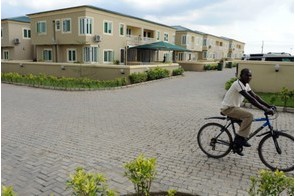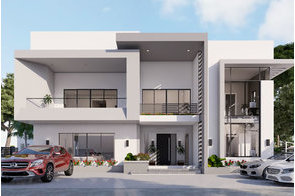Building for the demand for future housing

Summary
The homes of the future would have to be resilient, capable of adapting to exigent natural and man-made events, such as climate, financial and public health crises, while also protecting the cultural identity of communities.
We already have broad insights into the future of housing. That future, although already here and unnoticed by some people, will become more apparent in the coming years and decades. New technologies, novel designs, innovative materials, and advanced tools are going to feature prominently in the housing of the future. But one word that will connect all these new attributes is “liveability.” It was presumed that homes were developed to be liveable, but contemporary events have shown that this is not always the case.
Some of the challenges of the 21st century include rapid urbanization, over-crowded spaces, pollution, energy deficiency, and inadequate supply of liveable and affordable housing. While these are offshoots of the last century, new solutions are required to address them. The possibilities for this include new architectural designs and housing production processes that can significantly reduce overall financial cost, time and resource utilisation.
Our view of the housing of the future is not just about predicting trends, forecasting that architecture will become more flexible, integrate technology, and incorporate efficient and sustainable living into lifestyles. It is also an acknowledgment of the fact that these changes are inevitable, and so must be delivered.
The response to this need is growing. Around the world, we are seeing new real estate developments that are not only affordable, but are also shared, eco-friendly, flexible, stylish, and healthy. These sustainable alternatives to the traditional homes now make up 4 to 6 percent of all new residential units built per year, according to research from Boston Consulting Group.
A lifestyle of ease and comfort is one of the expectations of the future homeowner. For instance, the construction industry is expected to incorporate Artificial Intelligence (AI) into future homes in response to the new demand. Pop culture and movie industries have started to use AI as assistants to ease labour and drive efficiency in a consistent manner. Providers in the housing value-chain as developers, constructors, and manufacturers now need to accelerate on innovation and technology to modernise delivering of housing.
The changes in the demand for housing is spurred not only by desires for lifestyle improvement. The two existential threats the world currently faces – climate change and the COVID-19 pandemic – are reinforcing the need for adapting building conventions. The liveable future home is required to be resilient to extreme weather events, utilise natural light, support broader environmental sustainability, offer protection from the spread of infectious diseases and promote safe social interactions. Promoting wellness and community is also a core target of sustainability in real estate development.
Despite its embrace of these solutions – especially because adoption rate is still at a low base – the real estate sector is still more of a problem to sustainability. The environmental impact of real estate assets is highlighted by the fact that buildings account for 40 percent of global greenhouse gas (GHG) emissions, 50 percent of the world’s energy consumption, and 40 percent of raw material utilisation. To reach net zero carbon goal in real estate, we must take some crucial actions, including large-scale energy retrofit of older buildings and renovation or repurposing of buildings rather than demolishing them.
The homes of the future would have to be resilient, capable of adapting to exigent natural and man-made events, such as climate, financial and public health crises, while also protecting the cultural identity of communities. Assets should be able to withstand a variety of unpredictable stresses and be supple enough to adapt to changing patterns of working and living throughout their full lifecycle.
The scale of the changes that the COVID-19 pandemic has fostered in the housing sector is yet to be fully absorbed, or understood, especially in terms of its durability. Since the advent of the lockdowns in the first quarter of 2020, major cities around the world have recorded about 90 percent of their population spending their days indoors. As it turns out, pre-existing homes were not built for people to stay indoors for such an amount of time per day. Tensions in homes escalated, leading to sharp increases in cases of domestic violence around the world. Yet, the legacy of COVID-19 appears to be anything but temporary as working from home and virtual conferences and other learning events that are attended from home may become permanent in the way we work.
Indeed, this calls for changes in design and provision of shared facilities. Creating suitable habitats for a rich, culturally vibrant existence, the homes of the future should be inclusive in designs. Recreational facilities are required for liveable homes and communities.
More properties are needed in master-planned communities. Where this is not already the case, home buyers will require community amenities as part of the housing package they desire. In lieu of traditional yard requirements, buyers will begin to choose extra space within their communities to make life easier and more pleasant. Some of the community amenities being sought after now include parks and green space, trail systems for walking and biking, resort style pools and clubs, first class gyms and courts, and commercial Centres.
In 2021, we extensively engaged the future at Bilaad. Throughout the year, we also substantially engaged our internal and external stakeholders, including through this forum. As the year winds up, we are grateful for the vision we shared for a sustainable housing sector and the opportunities we both point to and harnessed.
We remain committed to our stakeholders, not least our employees. Henry Ford once said, “The only thing worse than investing in your employees and having them leave is not investing in them and having them stay.” We are learning together to continue to deliver cutting-edge, sustainable housing solutions. We are building for the growing demand for future housing.
Happy Holidays Season.
Bilaad Realty Limited is an Abuja-based company focused on delivering sustainable real estate solutions.
Related
-
Buhari and the housing hope of Nigerians
Buhari's government should approach housing, not as a brick-and-mortar problem, but as a system.
-
At 62, Nigeria can celebrate and strive for sustainable housing
The supply of housing cannot improve without improvement in effective demand.
-
2023: Building for sustainability
Pull Quote: Q&A with Sadiq Suleiman, Chief Operating Officer, Bilaad Realty.










